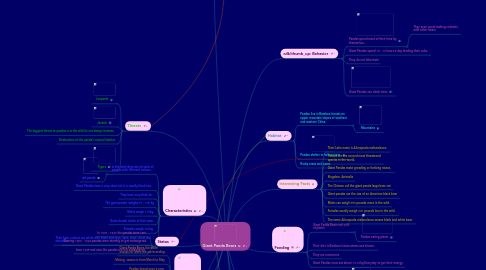Giant Panda Bears
создатель mah078 N


1. Characteristics
1.1. In the wild there are all sorts of pandas with different colours.
1.1.1. red panda
1.2. Giant Pandas have a very short tail it is usually black too.
1.3. They have very thick fur.
1.4. The giant panda weighs 70 - 125 kg
1.5. Males weigh 115kg.
1.6. Extra thumb inside of their paw.
1.7. Females weigh 100kg.
1.8. Their basic colours are white with black ears,legs, eyes, arms, chest and shoulders.
2. Threats
2.1. Leopards
2.2. Jackals
2.3. The biggest threat to pandas is in the wild its not always humans.
2.4. Destruction of the panda's natural habitat.
2.5. Tigers
3. Action Plan
3.1. Plant trees or plants
3.1.1. Trees provide oxygen and they are someone's habitat.
3.1.1.1. Help the earth
3.2. Follow the 3 r's Reduce, Reuse, And Recycle.
3.2.1. Recycle
3.3. Save paper
3.3.1. Saves Trees and plants and provides more food and shelter.
3.3.1.1. Use technology and not paper (just like this project).
3.4. planting seeds
3.4.1. More food for living things.
3.5. Don't purchase or eat any kind of wild meat.
3.5.1. Because each time you do a creature dies.
3.6. Make donations to pandas or a wildlife foundation.
4. How are Giant pandas endangered?
4.1. Fuel and wood used for cooking and heating
4.2. Bamboo harvesting
4.3. Road construction and mining
4.4. agriculture
4.5. Lumber/timber
4.5.1. This is Lumber
5. Breeding
5.1. Giant Panda Bears live alone except for when the are breeding.
5.2. Mating season is from March to May
5.3. Pandas breed once a year.
5.4. A Mother can only keep its cub for 6 months.
5.5. Giant Female pandas give birth after 90-160 days after mating.
6. Status
6.1. In 1960 - 1990 the pandas were rare.
6.2. Durring 1990 - 1994 pandas were starting to get endangered.
6.3. from 1995 and now the pandas are still endangered.
7. Biome
7.1. They live in bamboo forests.
7.2. coniferous forest.
8. Habitat
8.1. Pandas live in Bamboo forests on upper mountain slopes of southern and western China.
8.1.1. Mountains
8.2. Pandas shelter in hollow trees
8.3. Rocky areas and caves
9. Behavior
9.1. Pandas spend most of their time by themselves.
9.1.1. They even avoid making contacts with other bears.
9.2. Giant Pandas spend 10 - 12 hours a day feeding their cubs.
9.3. They do not hibernate
9.4. Giant Pandas can climb trees
10. Feeding
10.1. Giant Panda Bears eat 99% of plants
10.1.1. Pandas eating plants
10.2. Their diet is Bamboo leaves,stems and shoots.
10.3. They are omnivores
10.4. Giant Pandas must eat about 12-38kg Everyday to get their energy.
11. Life Span
11.1. A newborn panda cub weighs 90-130grams.
11.1.1. Cubs
